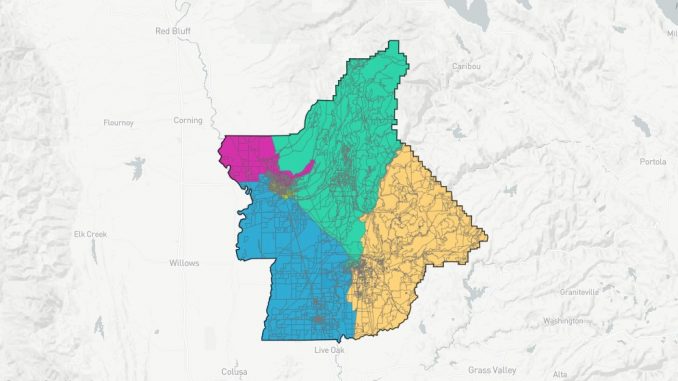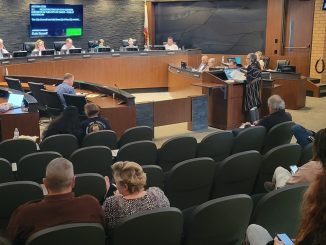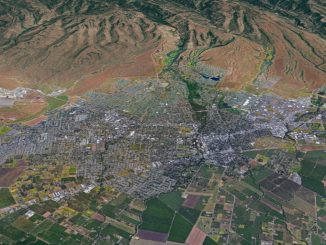
After another long, contentious meeting, the Butte County Board of Supervisors decided to move forward with three draft district maps on Tuesday (Dec. 6).
They’ll be considered at next week’s meeting on Tuesday, Dec. 14, at which a final map must be chosen to meet the Dec. 15 deadline.
Much of the debate at the several-hours long special meeting—which included more allegations of gerrymandering—came down to a question of what communities should be prioritized when creating the maps.
Two of the maps moving forward—A10, drawn by county consultant Redistricting Partners, and A5-C, drawn by Supervisor Tod Kimmelshue—prioritize keeping two western “valley” or agricultural districts and also split Chico into four districts. They are favored by the board’s conservative majority (the vote for each was 3-2, with supervisors Tami Ritter and Debra Lucero dissenting). The third map option, A7, is the amended version of a map (A6) that garnered much public support during the Supervisors’ Nov. 22 meeting and prioritizes minimally splitting Chico. (All maps can be viewed online here.)
Ritter and Lucero voted in support of A7. Though Supervisor Doug Teeter voted at a previous meeting to scrap the A6 map it is based upon, this Tuesday, he cast the third vote in support of it returning to the Dec. 14 meeting.
One of Ritter and Lucero’s main concerns came down to a question of the legality of maps A10 and A5-C.
The redistricting process must follow the California’s Fair And Inclusive Redistricting for Municipalities And Political Subdivisions (or Fair Maps) Act. It includes criteria that government agencies must meet “as much as practical,” including creating compact, contiguous districts of equal size and creating intact communities of interest, which are defined as “a population that shares common social or economic interests that should be included within a single supervisorial district for purposes of its effective and fair representation.”
Ritter and Lucero argued that keeping two agricultural districts violates that definition.
“Yes, ag is definitely a community of interest. … But then [the definition] says should be included within a single district for the purposes of effective and fair representation,” Ritter said. “I am concerned about the liability we are going to put this community in.”
Chris Chaffee, chief operating officer of Redistricting Partners, told the supervisors that it is up to the panel to decide which communities of interest to prioritize, with the caveat that “it’s important to say why you made a choice.”
Some of the top requests from the public include keeping Cohasset in a foothills district; splitting Chico as little as possible; keeping Bidwell Park and the Barber and Avenues neighborhoods within Chico districts; minimally splitting Oroville; using the Feather River as a dividing line for Oroville; keeping Honcut and Berry Creek within a foothills district; keeping the Mechoopda Indian Tribe of Chico Rancheria’s ancestral land united and within a Chico district; and keeping two agricultural districts on the west side of the county.
At the Supervisors’ meeting on Nov. 22, map A6 (the map A7 was derived from) and a map drawn by Josh Cook (69836), Republican state Senator Brian Dahle’s chief of staff, were up for consideration. At that time, Chaffee recommended that the Supervisors adopt map A6 and called map 69836 a “partisan gerrymander.” Both were ultimately scrapped, but the consultant was given direction by the conservative majority to create maps that favor two western agricultural or “valley” districts—the same priority that was used for the 69836 map.
Lucero argued that the board majority was disregarding overwhelming public testimony that asked for Chico to be minimally split, and accused her conservative colleagues of gerrymandering.
Chairman Bill Connelly told Lucero to “quit throwing gerrymandering around.”
“We threw the map out—move on,” he said.
Lucero replied: “This is the same result.”
Later in the meeting, she argued that splitting Chico in the way proposed by the A10 and A5-C maps “is a disenfranchisement” of people of color, students, and low-income households that live inneighborhoods near Chico State.
While voicing his support for maps A10 and A5-C, Teeter argued that rural communities in unincorporated county areas could be disenfranchised if the Supervisors prioritized the city or urban areas instead, and that he didn’t “see a fence at the Chico city limits.”
“There’s input that supports that decision [for valley/ag districts]—that’s what you’re looking for, that’s what makes it defendable,” he said.
The next meeting on districting will be Dec. 14. Go to buttecounty.net/clerkoftheboard/boardmeetings for the agenda and public commenting information.




Be the first to comment